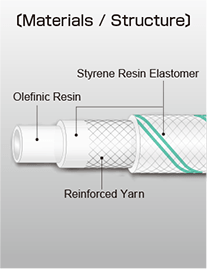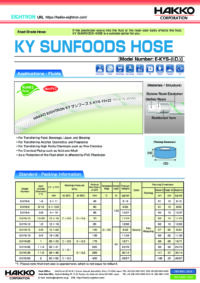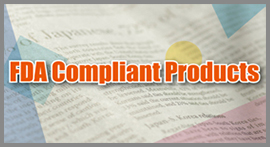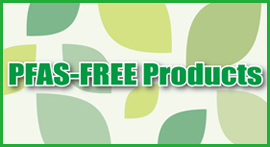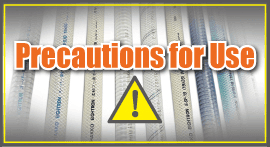KY SUNFOODS HOSE [Model Number: E-KYS]
Food Grade and Industrial Hose | Alcohol Resistant Hose | Moderate Chemical Resistant Hose | If the plasticizer soaks into the fluid or the resin odor badly affects the fluid, KY SUNFOODS HOSE is a suitable choice for you.
Fluids
 chemicals
chemicals food
food drink
drink alcohol
alcohol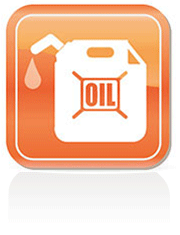 oil
oil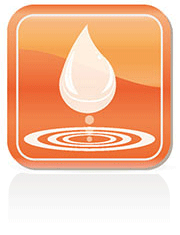 water
water powder
powder air
air Applications
- For Transferring Food, Beverage, Liquor and Brewing
- For Transferring Alcohol, Cosmetics and Fragrance
- For Transferring High Purity Chemicals such as Fine Chemical
- For Waste Water and Chemical Pump
- For Transferring Cooling Water for Supercomputer and Semiconductor Device
- For Transferring Coolant Liquid (Ethylene Glycol) as a Chiller Piping
- For Chemical Piping such as Acid and Alkali
- For Transferring Sodium Hypochlorite as the Purpose of Sterilization and Disinfection
- As a Protection of the Fluid which is affected by PVC Plasticizer
Functions
Non-PVC
Chemical Resistance
Low Elution
Low Odor
Food-Sanitation
Pressure-Proof
Alcohol Resistance
Characteristics
- Non-PVC...E-KYS is an eco-friendly hose, which is made of Olefin Resin and Styrene Resin.
- Plasticizer-Free...E-KYS does not contain plasticizer (an elution material) at all.
- Low Elution and Low Odor...Compared with PVC hose, elution levels are low. It is suitable for transferring food, beverage and cosmetics.
- Moderate Chemical Resistance...Since the inner layer is made of Olefin Resin, E-KYS shows moderate levels of chemical resistance.
- Easy to Cut...Since we print the cut mark on the hose every meter, it is easy to cut the length you would like to.
- Transparency...E-KYS (natural color) enables you to check the fluid very easily.
- Original Fittings...By using our original fittings, you can avoid accidents which are caused by incorrect choices of hose and fittings. For more information on our original fittings, please scroll down to the end.
- Hose Cap...By sealing the hose end by hose cap, the inclusion of foreign matters is prevented. E-KYS is tightened with hose cap only in the standard length.
Certificates and Regulations
- RoHS Compliant...E-KYS is compliant with RoHS requirements (Directive: (EU) 2015/863). (RoHS Compliant means that E-KYS does not contain RoHS 10 restricted substances or they do not exceed the upper threshold of RoHS 10 restricted substances.) Certificate is available on request. ICP data (Contained Amount Analysis Data of RoHS Restricted Substances) are also available on request.
- Non-Use of UV-328...E-KYS does not contain UV-328. Certificate is available on request.
- Non-Use of PFAS...E-KYS does not contain PFAS substances. Certificate is available on request.
- Food Sanitation..E-KYS conforms to the Food Sanitation Law No.380 (No.380 of the Ministry of Health and Welfare for Food Sanitation) (Conformity to N-Heptane) and the Partial Revision of Standards for Food and Additives (Positive List System) [No.324 of the Ministry of Health, Labour, and Welfare]. Regarding the conformity of “Partial Revision of the Food Sanitation Law” (Effective on June 1, 2020) and Positive List System (PL), please download here.
- TSCA (Toxic Substance Control Act) Compliance...E-KYS does not use decaBDE, PIP(3:1), 2,4,6-TTBT, PCTP and HCBD. Certificate is available on request.
Packing Images
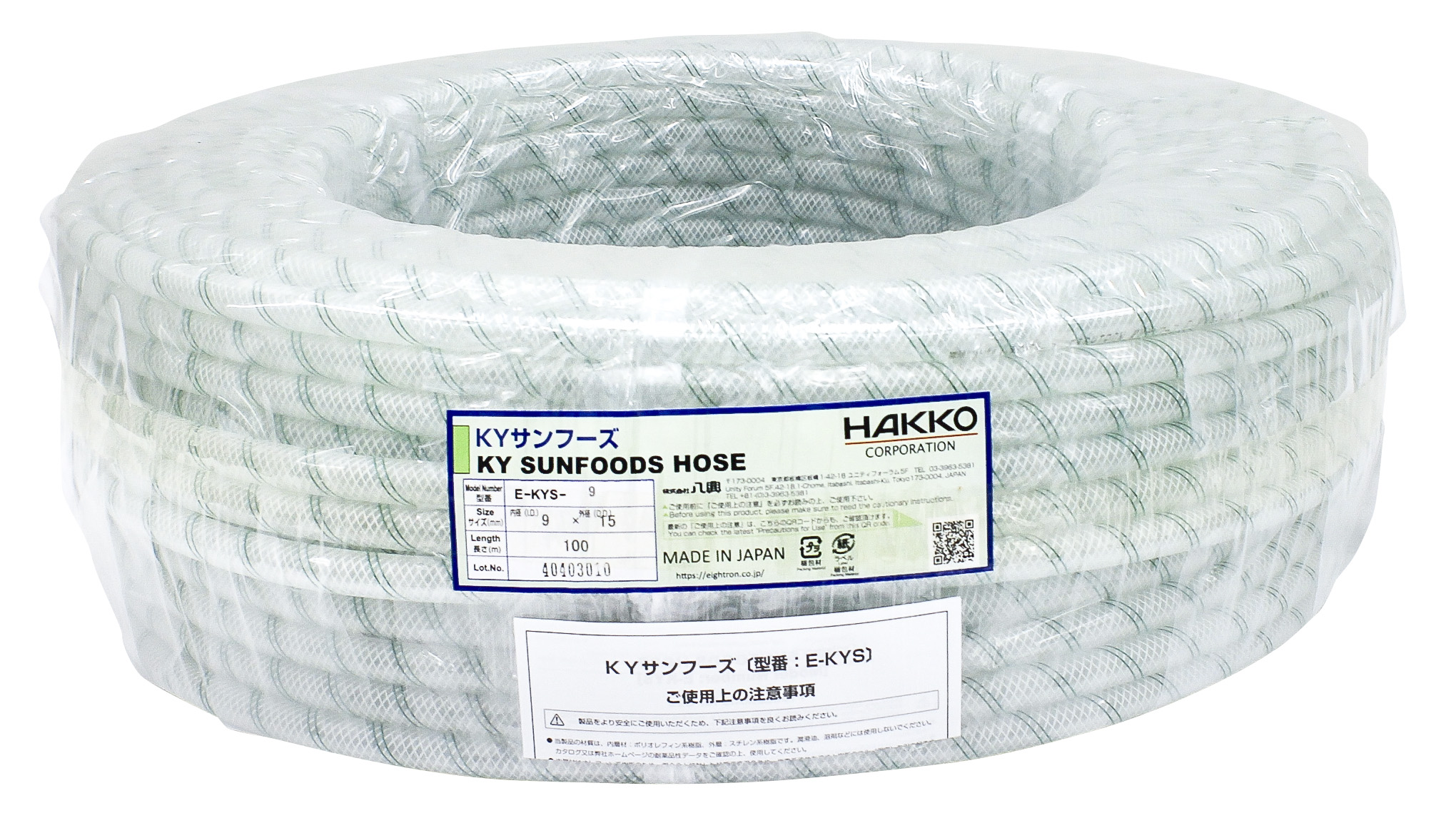
Product Standard
Standard Size
Made-to-Order Size Example
- Temperature Range : 0 - 65 $^\circ$C
- Color : Natural
*Please note that the value of "Minimum Bend Radius" is NOT equal to that of "Flexibility." About "Flexibility," please contact us and request the sample.
*If you are interested in Made-to-Order size (such as Inch Size and I.D. 4mm$\times$O.D. 9mm for chemical pump use), please fill out the following form. (We can also produce a special size that is not listed on the table above. Please note that MOQ applies for made-to-order size.)
Made-to-Order Inquiry Form
Leaflet Request
For more information on our Product Standard of E-KYS, please click "Product Leaflet Download" above.
Specification Request
For more technical information (such as Thickness of Each Layer and Precautions in Use) on E-KYS, please click "Product Specification Download" above.
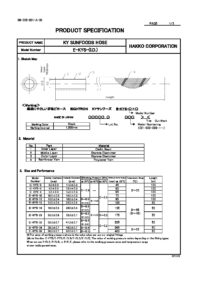
Cautions:
- Due to the laminated structure hose, please use the joints to seal an inner surface of the hose.
- Please do not use the joints to seal an outer surface of the hose. This may result in the bursting or coming off from the hose.
- When you use our products, please refer to "Precautions for Use." ("The Precautions for Use" of E-KYS is also downloadable here.)
- In terms of chemical resistance, please refer to "Chemical Resistance Data."
- Although the inner layer is resistant to fluids, depending on working environments, the fluids would be permeated through the inner layer, resulting in the danger of swelling and degradation of the middle or outer layer.
Case Study
Problem: Black Mold Contamination to the Final Product
Company A, manufacturing alcohol gel, has been using PVC hoses to fill in the cooling gel. However, the black mold appeared on the final product. After their investigation, it turned out that the black mold came from the plasticizer that PVC hoses have. Company A needs to look for the alternative product.
HAKKO Solution:
HAKKO proposed E-KYS: KY SUNFOODS HOSE and provided a sample. E-KYS is made of non-PVC materials, and does not contain any plasticizer. After 6 months’ trial, Company A confirmed that there was no black mold on the final product. Company A was very satisfied with E-KYS and decided to adopt E-KYS for all pipes of cooling gel in their factory.
Frequently Asked Questions
Question: We are a machine maker. We would like to use a 30-meter of E-KYS-25 for each machine, but the standard length is 50 meter. Could you make the standard length longer to 60 meter?
Answer: Yes. We can manufacture a longer standard length of E-KYS-25. Please fill out the form.
Question: How do we wash out the food grade hose?
Answer: To wash out the inner layer of the hose, we recommend you to use a sponge ball and rocket brush.
Question: We understand that an inner layer of E-KYS is made of Olefin. What kinds of chemical can be transferred through Olefin?
Answer: Although in terms of chemical resistance, Olefin is lower than Fluorine. However, some types of chemicals are still transferrable. For instance, isopropyl alcohol, phenol, alkali, methanol, ethanol and sodium hypochlorite are transferrable. (Please note that depending on the other using conditions, those chemicals might not be resistant against Olefin. Please check in advance.)
Technical Information
(A) Relationship Graph between Working Temperature and Maximum Working Pressure
(B) Combustion Gas Data on Raw Material of KY SUNFOODS HOSE
*Test Method: JIS K7217
(C) Leach Test Data
Notes: Depending on the materials of the hose, plasticizer and stabilizer may elute. Data on the above show the levels of low elution of E-KYS. The results above are measured values are NOT guaranteed.
*Test Method: JIS S 3200-7: 2004 [Equipment for Water Supply Service]
*Test Method: JIS S 3200-7: 2004 [Equipment for Water Supply Service]
*Hose Cleaning-Up
If you wash the hose in hot water, hot water must be lower than 80 $^\circ$C (176 $^\circ$F), less than 30 minutes and less than 0.1 MPa (1kgf/cm2) (One-Side Free Condition).
HAKKO Original Fittings for E-KYS
| Product Name | Materials, Characteristics |
| EIGHTLOCK S Fittings [Model Number: E-ELS]] |
- Material: SUS304 (SS304) (Body, Ring, Nut), POM (Sleeve)
- Our Nut Type Original Made-in-Japan Fittings
- Since the inner layer of the fitting is flat and does not use the rubber packing, fluid accumulation is unlikely to occur. Thus, it is easy to wash out.
- Since you do not need hose clamp and the controlling torque value, you can standardize how to install the fitting.
|
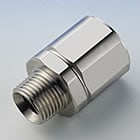
|
| EIGHTLOCK B Fittings [Model Number: E-ELB]] |
- Material: BSBM (Body, Ring, Nut), POM (Sleeve)
- Our Nut Type Original Made-in-Japan Fittings
- Since the inner layer of the fitting is flat and does not use the rubber packing, fluid accumulation is unlikely to occur. Thus, it is easy to wash out.
- Since you do not need hose clamp and the controlling torque value, you can standardize how to install the fitting.
|
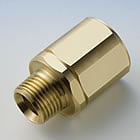
|
| EIGHTNIPPLE S Fittings [Model Number: E-FTS]] |
- Material: SUS316L (SS316L)
- SUS316L (SS316L) is superior in corrosion resistance, so you can transfer a wide range of fluids.
- Two-stage flat nipple structure which maximizes hose pressure
- Our Original Barb Nipple Fittings
- Made-in-Japan Fittings
|
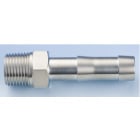
|
| EIGHTNIPPLE B Fittings [Model Number: E-FTB]] |
- Material: BSBM (Brass)
- Compliant with RoHS2 requirement
- Two-stage flat nipple structure which maximizes hose pressure
- Our Original Barb Nipple Fittings
- Made-in-Japan Fittings
|

|
| EIGHTLOCK Ferrule Fittings [Model Number: E-ELF]] |
- Material: Body: SCS16, Nut and Ring: SCS13 (Sleeve: POM)
- You can replace a hose even though the hose needs replacement, since EIGHTLOCK Ferrule Fitting is a nut ferrule fitting. You can install and detach the fitting on site.
- You can make use of a wide range of usages such as pipes for chemicals, food, beverage and alcohol.
- The nipple end is less likely to accumulate fluids, so you do not have to worry about contamination very much.
|

|
| EIGHTLOCK Ferrule Fittings with PFA Lining [Model Number: E-ELF-PFA]] |
- Material:Body: SCS16, Wetted Part: PFA Lining, Nut and Ring: SCS13 (Sleeve: POM)
- Due to PFA Lining, you can transfer fluids that are not possible for metal fittings.
- You can replace a hose even though the hose needs replacement, since EIGHTLOCK Ferrule Fitting is a nut ferrule fitting. You can install and detach the fitting on site.
- You can make use of a wide range of usages such as pipes for chemicals, food, beverage and alcohol.
- The nipple end is less likely to accumulate fluids, so you do not have to worry about contamination very much.
|
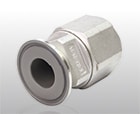
|
| EIGHTLOCK S Fittings (with Hose Guide) [Model Number: E-ELS-GN]] |
- Material: SUS304 (SS304) (Body, Ring, Nut), POM (Sleeve)
- Our Nut Type Original Made-in-Japan Fittings with Hose Guide
- Since the inner layer of the fitting is flat and does not use the rubber packing, fluid accumulation is unlikely to occur. Thus, it is easy to wash out.
- Since you do not need hose clamp and the controlling torque value, you can standardize how to install the fitting.
|

|
Cautions:
- For EIGHTNIPPLE S and B Fittings, please fasten with two hose clamps.
- For EIGHTLOCK S, B and Ferrule Fittings, its sleeve is not reusable. When you reinstall a hose, please use a new one.
- Working temperature range with EIGHTLOCK S, B and Ferrule Fittings is not the same as without EIGHTLOCK S, B and Ferrule Fittings. For more information, please visit the product page of EIGHTLOCK Fittings.
HAKKO Original Accessory for E-KYS
| Product Name | Materials, Characteristics |
| Protective Spring Guards [Model Number: E-HSL]] |
- Material: SUS304 (Band, Spring and Fastener)
- Spring guards prevent kinking, so you can transfer fluids safely.
- E-HSL prevents kinking even if the bending radius is small due to the space-saving piping.
- When you install E-HSL on the fitting, E-HSL can be used as an alternative to flat band.
|

|


